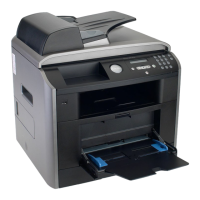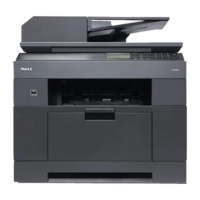195Network
Network Shared Printing
In a Network Shared environment, each computer sends data via a centrally controlled computer. This type of
computer is often called a "Server" or a "Print Server". Its job is to control all print jobs.
1. Client Computer
2. Centrally controlled computer, also known as the "Server" or "Print Server"
3. Ethernet Cable or USB
4. Network Machine (your machine)
NOTE: In a larger network, we recommend a Network Shared Printing environment.
NOTE: The "Server" or the "Print Server" must use the TCP/IP protocol.
NOTE: The Dell machine needs to have an appropriate IP address configuration, unless it is connected via the USB
interface at the server.
Wireless Network Connection Examples
Identify your wireless network connection type: Infrastructure mode, Ad-Hoc mode, or Wi-Fi Direct™ mode.
• Connected to a Computer with a Wireless LAN Access Point Router in the Network (Infrastructure Mode)
This type of network has a wireless LAN central access point/router at the heart of the network. The access point
can also act as a bridge or a gateway to a wired network. When the Dell wireless machine (your machine) is part
of this network, it receives all print jobs via an access point.
• Connected to a Wireless Computer without a Wireless LAN Access Point Router in the Network (Ad-Hoc Mode)
This type of network does not have a central wireless LAN access point/router. Each wireless client communicates
directly with each other. When the Dell wireless machine (your machine) is part of this network, it receives all
print jobs directly from the computer sending print data.
• Wi-Fi Direct

